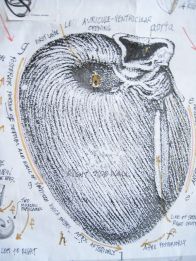 Frank’s exploration of the relationship between form and spirit led him to do deep creative research on the number seven. By applying an alchemical transformative process to his seven-sided form, he has discovered many previously unknown geometric structures that demonstrate a remarkable correlation to the form and functioning of the human heart. These forms and Frank’s artistic process have much to teach us about the objective realities of Living Thinking.
Frank’s exploration of the relationship between form and spirit led him to do deep creative research on the number seven. By applying an alchemical transformative process to his seven-sided form, he has discovered many previously unknown geometric structures that demonstrate a remarkable correlation to the form and functioning of the human heart. These forms and Frank’s artistic process have much to teach us about the objective realities of Living Thinking.
“Balancing” says Frank, “is the primary function of the heart. Our inner work improves balance. When we are able to see ‘periphery’ and ‘center’ simultaneously; when we see ‘self’ and ‘other’ with equal equanimity, then we give the heart a loosening quality of balance that allows it to evolve etheric forces.
Frank summarizes some of the details:
“The heart is not a pump, but an organ in which etheric space is created, so that the blood is sucked into the heart rather than pumped”(1). January of 2000 a new form was uncovered with 7 equal surfaced areas. After four years of study it was found to be the geometry behind the human heart. Based on the precise objective nature of geometry it can now be shown and validated by this lawful 7-sided form that many of Rudolf Steiner’s statements concerning the human heart are true.
Form Has a Function
Function Has a Form
Follow the Form
THE HEART FORM IS PRECISION IN BALANCE between inversion and reversals, suction and pressure, concave and convex, right and left, backwards and forwards, below and above, three and four, asymmetrical and symmetrical, acceleration and deceleration, clockwise and counter-clockwise, geometric and organic, and two different vortexes, all of which today can be demonstrated to be lawful. These polarities are found to be active in the human heart.
1. The heart is a brake, “The heart is not a pump; it is a sense organ, a damming up organ”(2) You can observe the chestahedron in a vortex generator balancing itself between accelerating and decelerating.
2. The apex of the heart is paper-thin. “The apex wall is so soft and weak that it can be pierced with the index finger”(3) The geometry of the mitral valve opening will not allow a moving vortex to reach the apex inside the chestahedron. If the heart is a pressure pump, the apex would balloon out. The new form shows why this ballooning does not occur.
3. The chestahedron’s geometry consists of two vortexes, one inside the other. “The musculature of the heart and arteries all the way down to the pre-capillaries is spirally oriented, and both the heart and arteries move spirally to augment the momenta of the blood.”(4)
4. After creating a vortex in a clear receptacle of water with the chestahedron on the end of an electric drill, there remains three spiraling vortexes. “Dr. Pettigrew found three columns of spiraling blood in the left ventricle.”(5)
5. By using the chestahedron geometry of 22.5 degrees of arc found in the center of the conical form, we now have an answer to myocardial layering design that has eluded Dr. Pettigrew, Lawrence Edwards and all present-day heart researchers. A design that allows counter clockwise and clockwise forces to work together in a balanced way and at the same time promote blood vortex movement.
6. The chestahedron was developed from a tetrahedron turning inside a cube whose axis is centered at the squre root of 3, and the square root of 3 in the cube is 36 degrees of arc from the horizontal plane. This explains for the first time why the heart is located on the left side of the body. The human heart position in the body is 36 degrees, which is the perfect balance between above and below, right and left and forward and behind. Not knowing about geometry, many studies indicate the heart sets at 45 degrees.
7. When the tetrahedron reaches the midpoint of the cube the resulting form is an octahedron with one invariant point. Putting this form back into the original tetrahedron and spinning both at the same time in the cube again, you get the inside left ventricle geometry.
8. The inside left ventricle geometry turns 40 degrees during systole and sits in the cube at 15 degrees. Altogether you have a 55-degree spiral movement. If the ventricle twists another 5 degrees a dynamic, functional “fifth chamber” develops complete with a tricuspid valve.
(Reference information will be posted in the future.)
You must be logged in to post a comment.